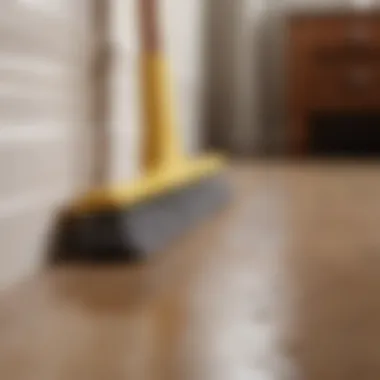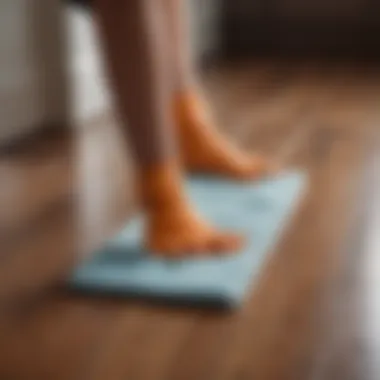The Ultimate Guide to Spotless Baseboards: Tips & Tricks


Intro
Cleaning baseboards is more than a routine chore; it’s a vital part of home maintenance that enhances aesthetic appeal and complements the overall design of a space. Clean baseboards reflect attention to detail and care for one’s home. In this guide, we explore the reasons behind the necessity of clean baseboards, various effective cleaning methods, essential tools, and practical tips for maintenance. Understanding the significance of this often-ignored aspect helps homeowners maintain a polished and inviting atmosphere, essential for anyone looking to elevate their living space.
Exquisite Architectural Designs
Baseboards do not just serve a functional purpose; they also contribute to the architectural integrity and beauty of a home. When considering design aspects, one must acknowledge how baseboards frame for walls and floors, creating a seamless transition between different elements of the home’s interior.
Unique Home Features
Many homes showcase unique features in their baseboard designs. Some of these might include intricate carvings or patterns specific to historical styles or even modern minimalist looks. These elements enhance character and can often be a focal point in rooms. The type of baseboard can depend on architectural styles, ranging from Victorian intricacies to clean lines found in contemporary designs. Homeowners should choose a baseboard that reflects the broader design philosophy of their space.
Historical Significance
The history of baseboards dates back centuries, with styles evolving to reflect cultural and regional tastes. In older homes, baseboards often served as protective barriers against damage from furniture and foot traffic. They also played a role in illuminating the craftsmanship of the era. Understanding this historical context can guide homeowners in selecting appropriate cleaning methods that preserve the integrity of these features.
"Baseboards are not merely an afterthought; they are an important aspect of a home's architectural dialogue."
Interior Decorating Tips
To maintain the visual harmony in a space, baseboards should be kept clean and in line with the decor. It is essential to consider how they interact with other design elements in a room.
Color Schemes and Trends
Selecting a cohesive color scheme can ensure that baseboards complement wall colors, floor styles, and overall room aesthetics. Whether opting for crisp white, soft pastels, or dark tones, each choice affects the mood and perceived size of a room. Current trends lean toward contrasting baseboards, which can add depth to spaces, enhancing their visual appeal.
Space Optimization Techniques
When choosing baseboard height, consider how it affects the perception of space. Taller baseboards can make ceilings appear higher, giving the illusion of an expansive area. In contrast, shorter baseboards might make a room feel cozier. Homeowners should think of baseboard cleaning not just as maintenance but as part of a broader strategy to optimize their space.
In summary, clean baseboards contribute significantly to the aesthetic and physical quality of a home. By appreciating their architectural relevance and decorative potential, one can better understand the importance of maintaining this often-dismissed element of home design.
Prelude to Baseboard Cleaning
Cleaning baseboards is not often at the forefront of home maintenance discussions, yet it holds a vital role in overall interior cleanliness. Baseboards can accumulate dust, dirt, and grime quickly, which not only detracts from the home’s aesthetic but can also contribute to poor air quality. A thorough understanding of this cleaning process elevates the overall maintenance of a space, making it visually pleasing and healthy for occupants.
Regular cleaning of baseboards provides various benefits. First, it removes entrapped allergens such as dust mites and pet dander, promoting better respiratory health. Second, well-maintained baseboards add to the polished look of a home, enriching its appeal. Lastly, cleaning them helps preserve their condition, ultimately prolonging their lifespan and saving money on future repairs or replacements.
Consideration must also be given to the materials used in baseboards and the cleaning techniques suitable for each type. Different materials, like wood, vinyl, and MDF, require specific products for effective cleaning. Ignoring these details can lead to damage, rather than cleanliness. Thus, this guide does not only discuss how to clean baseboards, it emphasizes the why behind it.
In summary, understanding the significance of baseboard cleaning is crucial for anyone who values a clean and healthy living environment. The forthcoming sections will delve deeper into the types of baseboards, the tools required, and practical cleaning methods that one can implement easily.
Understanding Baseboards
Baseboards, often overlooked components of interior design, serve both functional and aesthetic roles. Located at the junction of walls and flooring, they cover gaps and provide a finished appearance. They come in various materials, shapes, and sizes, reflecting personal styles and preferences in home decor.
From traditional wooden baseboards that exude warmth and elegance to the modern, sleek lines of vinyl or MDF options, each type offers distinct advantages. The choice of material often depends on factors such as budget, durability, and design intent.
Baseboards also play a protective role in preventing wall damage from furniture, foot traffic, and moisture intrusion. Thus, understanding what baseboards are and their purposes is the first step toward proper care and maintenance.


Why Clean Baseboards?
Cleaning baseboards is a necessary practice that contributes significantly to home maintenance. There are several reasons to prioritize this task:
- Healthier Environment: Dust buildup on baseboards contributes to allergens in the air. Regular cleaning minimizes these irritants, providing a healthier space.
- Enhanced Appearance: Clean baseboards significantly improve the overall look of a room. They are one detail that can either draw attention or be a point of neglect.
- Longevity: Maintaining the aesthetics of baseboards prolongs their lifespan. Dirt, stains, and grime can degrade materials over time, leading to costly repairs.
- Psychological Impact: A clean environment can boost morale and instill a sense of order and comfort.
"Regular upkeep of baseboards is an investment in your home’s beauty and functionality."
In summary, the act of cleaning baseboards should not be dismissed. It is a simple yet impactful task that bears significant rewards, from health benefits to aesthetic enrichment.
Types of Baseboards
Understanding the various types of baseboards is crucial for effective cleaning and maintenance. Each type of baseboard material comes with its own unique properties, making them better suited for specific environments. Knowing these details can help homeowners make informed choices regarding cleaning methods, tools, and products. Selecting the right approach can greatly enhance the longevity and aesthetics of baseboards in any space.
Wooden Baseboards
Wooden baseboards are popular for their timeless appeal and durability. They can add warmth and character to any room. However, they require specific care to maintain their finish. Dust and dirt can accumulate over time, leading to a dull appearance. When cleaning wooden baseboards, it is important to use gentle cleaners that do not damage the lacquer or paint. Soft cloths or microfiber dusters are preferred for regular dusting. For deeper cleans, a solution of water and mild soap can be utilized.
"Avoid harsh chemicals as they may strip the wood's finish."
Regular assessments for scratches or discoloration will help in taking prompt corrective actions. Using wood polish not only cleans but can also nourish the wood, ensuring that the baseboards retain their elegance.
Vinyl Baseboards
Vinyl baseboards are often used in areas prone to moisture, such as bathrooms and kitchens. They are durable, easy to clean, and resistant to water damage. Their synthetic material allows for various designs and colors, making them versatile for different decor styles. The cleaning process for vinyl baseboards is straightforward. A mixture of vinegar and water can effectively remove dirt and grime without harming the material.
Sponge or soft brushes can be used to scrub away stubborn stains. Regular cleaning can prevent buildup, thus maintaining their fresh appearance. It is recommended to apply a protectant or polish designed specifically for vinyl to further enhance durability and gloss.
MDF Baseboards
Medium Density Fiberboard (MDF) baseboards are a cost-effective alternative to solid wood. They can mimic wood's appearance without the high price. However, because MDF is made from wood fibers and resin, it is less resistant to moisture and can warp if exposed. Cleaning MDF requires caution. Using a damp cloth can help remove dust and light stains, but excess water should be avoided as it can lead to damage.
A safe approach is the application of a gentle cleaner, followed by thorough drying. Keeping MDF baseboards protected from extreme humidity will extend their lifespan. For those requiring a fresh look, painting is an option, offering an opportunity to match the baseboards with the room's color scheme.
In summary, identifying the type of baseboards in your home is essential for appropriate cleaning and maintenance. Each material has its strengths and weaknesses, which must be considered when creating a cleaning routine.
Tools and Supplies for Cleaning Baseboards
Understanding the right tools and supplies for cleaning baseboards is crucial for efficiency and effectiveness. This section highlights various essentials that ensure a proper clean. Choosing suitable items makes the cleaning process smoother and can even impact the overall appearance of your baseboards. Proper tools help prevent damage to the material and can save time, making cleaning less burdensome.
Basic Cleaning Tools
Basic cleaning tools form the foundation of any baseboard cleaning regimen. These items are often readily available in most households, making them convenient to use. Here are some essential tools:
- Microfiber Cloths: These are effective in trapping dust and dirt without scratching surfaces.
- Vacuum Cleaner: A vacuum with a brush attachment can help remove debris from tight corners.
- Duster: A long-handled duster is useful for reaching high baseboards and corners.
- Bucket: For any washing tasks, a bucket can be used to carry cleaning solutions.
- Mop: For deeper cleaning, a flat mop can reach and clean lengthy baseboards.
Each of these items plays a role in achieving a thorough clean. Quality microfiber cloths, for example, are gentle on surfaces while effectively capturing dust. A vacuum cleaner with a brush attachment offers an efficient way to tackle dirt that may settle in challenging spots. Investing in good tools will encourage regular cleaning and maintenance.
Specialized Cleaning Products
Choosing specialized cleaning products assists in addressing specific issues like stains, scuff marks, and dirt buildup. These products enhance cleaning effectiveness compared to typical household cleaners. Some recommended products include:


- All-Purpose Cleaner: This can serve as a versatile solution for general cleaning tasks.
- Wood Polish or Wax: Ideal for wooden baseboards, it not only cleans but also protects the finish.
- Vinyl Cleaner: If your baseboards are vinyl, then using a cleaner specifically designed for this material prevents damage to its surface.
- Stain Removers: For tough stains, a good stain remover can be beneficial.
Using specialized products means ensuring the longevity of your baseboards. For example, applying wood polish regularly can help in maintaining the shine and condition of wooden baseboards. Always read the labels to confirm compatibility with the materials of your baseboards.
Protective Gear
Although baseboard cleaning is often seen as simple, it can involve substances that may cause irritation. Protective gear helps to guard against potential hazards. Consider the following:
- Gloves: Wearing rubber gloves protects skin from harsh chemicals or dirt.
- Mask: A mask can help keep dust and allergens at bay, especially for those with sensitivities.
- Knee Pads: If you will be kneeling on hard surfaces, knee pads provide comfort and protection.
Using protective gear ensures safety during the cleaning process. It allows you to focus on the task at hand without concern for irritation or discomfort. Especially when working with cleaning products or doing extended cleaning, this is vital.
"Selecting the right tools and supplies is a step towards achieving a clean and appealing home environment."
Step-by-Step Cleaning Process
The step-by-step cleaning process is integral to maintaining the appearance and longevity of baseboards. Following a structured approach ensures no area is overlooked, allowing for efficient cleaning and effective results. It not only enhances aesthetic appeal but also contributes to the overall hygiene of the home. Each step is designed to address different aspects of grime and dirt that accumulate over time.
Preparation
Before diving into the actual cleaning process, preparation is key. Start by gathering all necessary tools and materials in one place. This includes a vacuum with a brush attachment, microfiber cloths, a bucket, and the appropriate cleaning solutions. If your baseboards are particularly dirty, consider having a scrub brush handy.
Before beginning, remove any furniture or obstacles that might hinder your movement along the baseboards. A clean workspace allows for smoother and more effective cleaning. Make sure to wear comfortable clothing and use protective gear if necessary. This could include gloves to protect your hands, especially if working with chemical cleaners.
Initial Dusting
Dusting is the first step in the cleaning process. Utilizing a vacuum with a brush attachment can effectively remove loose dust and debris from the baseboards. This prevents dirt from being ground into the surface during deep cleaning. If you do not have a vacuum, a microfiber cloth can be effective for this task.
Ensure you pay attention to corners and crevices, as dust tends to accumulate in those areas. For wooden baseboards, be gentle to avoid scratches. Regular dusting can prolong the intervals between deep cleaning, maintaining the overall cleanliness of the baseboards.
Deep Cleaning Techniques
Deep cleaning techniques vary depending on the material of the baseboards. For wooden baseboards, use a mild solution, such as a mixture of water and vinegar. This can help to cut through tough grime. For vinyl and MDF, a slightly stronger solution may be necessary, but always read labels to avoid damaging the materials.
Apply the cleaning solution with a cloth or sponge. Work in sections, allowing the solution to sit for a short time to dissolve stubborn stains. Rinse with clean water to avoid residue and potential stickiness. Pay special attention to areas where pet hair and dander gather, as these can lead to additional dirt buildup.
Final Touches
After deep cleaning, it is time for the final touches. Inspect the baseboards for areas that may need additional attention. Use a dry microfiber cloth to buff the surface and ensure no streaks remain. This is particularly important for wooden baseboards, which can show streaks easily.
Additionally, consider applying a protective coat to wooden baseboards after cleaning. This can shield them from future dirt buildup and enhances their shine. Regular final touches, such as a quick dusting and polishing, can ensure baseboards remain in pristine condition over time.
Common Challenges in Baseboard Cleaning
Cleaning baseboards presents several challenges that homeowners may often neglect. These challenges can deter effective cleaning routines, causing frustration and subpar results. Addressing these common issues is crucial to maintaining a pristine home environment. Understanding how to tackle stains, pet hair, and dirt buildup can enhance the overall cleaning experience. This section will explore these challenges in detail, offering practical solutions for each.
Stains and Scuff Marks
Stains and scuff marks on baseboards can arise from various sources. Furniture bumping against walls, shoes dragging dirt indoors, and spills are common culprits. Not only do they detract from the aesthetic appeal of a room, but they can also signify neglect in cleaning efforts.
To effectively remove these marks, identification of the stain type is necessary. For instance, water stains may require different treatment compared to scuff marks from shoes.


- For stubborn scuff marks: Use a magic eraser or a damp cloth with a bit of dish soap. This approach usually works well.
- For water stains, a mixture of vinegar and water can be effective. Applying it with a soft cloth gently may restore the baseboard without harming the finish.
Keeping your baseboards clean not only enhances the visual appeal but also prevents stains from becoming permanent.
Pet Hair and Dander
For pet owners, managing pet hair and dander on baseboards can be a significant challenge. Hair tends to accumulate in corners and along edges, creating visible clumps of fur and potential allergens. Regularly removing this debris is essential for both hygiene and aesthetics.
- To combat pet hair: A simple vacuum with a brush attachment is helpful. Alternatively, using a microfiber cloth can attract dust and hair efficiently.
- Dander control requires a different strategy. Ensuring your pets are bathed regularly and maintaining a clean living environment minimizes the buildup of allergens.
It's noteworthy that keeping baseboards free from pet hair and dander contributes to better air quality in the home.
Dirt Buildup in Corners
Dirt buildup in corners of baseboards can accumulate over time, making them appear dingy. This issue is frequently overlooked, yet it is an important factor in maintaining cleanliness. The dirt that collects in these areas not only impacts aesthetics but can also harbor pests if left unattended.
- To address this accumulation: Start with a thorough dusting using a long-handled duster. Follow up by using a damp cloth to wipe down the baseboards, paying special attention to corners.
- Regular maintenance: Implementing a routine cleaning schedule can help prevent dirt buildup. Aim for quick spot cleaning in high-traffic areas as part of your weekly cleaning ritual.
By being proactive about corner dirt, you can maintain cleaner baseboards and a healthier living space.
"A clean baseboard can say a lot about the overall maintenance of a home, reflecting care and attention to detail."
In summary, awareness of these challenges—stains, pet hair, and corner dirt—can significantly enhance your baseboard cleaning efforts. By embracing effective cleaning techniques tailored to each issue, homeowners can achieve a higher standard of cleanliness and aesthetic appeal.
Preventative Maintenance for Baseboards
Preventative maintenance for baseboards plays a significant role in keeping your home looking polished and well-maintained. Like any part of your home, baseboards collect dirt, dust, and wear over time. Implementing a preventative maintenance routine help minimizes the need for deep cleanings and ensures that baseboards remain in good condition. Regularly attending to your baseboards can prevent more severe issues, such as damage from moisture or scratches that may arise from neglect.
Regular Cleaning Schedule
Setting up a regular cleaning schedule is crucial for the upkeep of baseboards. Establishing a routine may seem tedious, but it saves time and effort in the long run. Aim to clean baseboards at least once a month to keep them looking their best. During this routine cleaning, consider the following actions:
- Dusting: Use a microfiber cloth or a duster to remove surface dust.
- Spot Cleaning: Check for any stains or marks and remove them promptly.
- Inspect for Damage: Look over the baseboards for chips or peeling paint, which should be addressed immediately.
By incorporating these tasks into your regular cleaning schedule, you'll prevent dust buildup and the formation of more significant dirt deposits.
Choosing the Right Products
Selecting the appropriate cleaning products is vital for effective baseboard maintenance. Some products are too harsh and can lead to damage, while others may not effectively remove buildup. Delve into the specific types of products suitable for each material of baseboard:
- Wooden Baseboards: Use a gentle wood cleaner or a solution of mild soap and water to avoid damaging the finish.
- Vinyl Baseboards: A multi-surface cleaner or a vinegar-water solution works best for these.
- MDF Baseboards: It’s safer to use a damp cloth with a little soap to keep MDF baseboards looking sharp.
Always test a new product on a small, inconspicuous area first to ensure it won’t harm the surface.
Protective Measures
Protecting baseboards from potential damage is an essential aspect of preventative maintenance. Here are some measures to consider:
- Furniture Placement: Avoid placing furniture too close to baseboards to minimize scratches and indentations.
- Use of Mats: Place mats or rugs where there may be high foot traffic, particularly in entryways to catch dirt before it reaches the baseboards.
- Regular Inspections: Conduct regular assessments to catch deterioration early. Address any water leaks that can damage baseboards before they become a significant issue.
Epilogue
Cleaning baseboards may seem a trivial task, yet it holds significant relevance in maintaining the overall aesthetic and hygiene of your living space. This article highlights the importance of clean baseboards, focusing on their roles in interior design and cleanliness.
The Aesthetic Importance of Clean Baseboards
Clean baseboards contribute immensely to the visual appeal of a room. They frame the walls, offering a finishing touch that enhances the overall design. If baseboards are grimy or discolored, they can detract from an otherwise well-decorated space. Maintaining their cleanliness signals attention to detail and care for the home. Clean baseboards can elevate the appearance of your interiors, making them feel polished and inviting.
Final Thoughts















